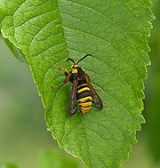
Hornet Moth
Encyclopedia
The Hornet Moth or Hornet Clearwing, (Sesia apiformis), is a large bulky moth
which is a brilliant natural imitation of a hornet. Despite this, however, the moth is perfectly harmless.
and the Lunar Hornet Moth
. The moth is as large as a hornet and even has the hornet's rather jerky flight when disturbed, but it has more yellow and lacks the waist between the abdomen
and the thorax
. Lunar Hornet Moths lack the yellow head and shoulders and has a black collar, unlike the Hornet Moth which has a yellow collar. The Lunar Hornet Moth flies from July to early August, though this is not a reliable identification guide.
Moth
A moth is an insect closely related to the butterfly, both being of the order Lepidoptera. Moths form the majority of this order; there are thought to be 150,000 to 250,000 different species of moth , with thousands of species yet to be described...
which is a brilliant natural imitation of a hornet. Despite this, however, the moth is perfectly harmless.
Identification
The Hornet Moth is easily confused with the real HornetHornet
Hornets are the largest eusocial wasps; some species can reach up to in length. The true hornets make up the genus Vespa and are distinguished from other vespines by the width of the vertex , which is proportionally larger in Vespa and by the anteriorly rounded gasters .- Life cycle :In...
and the Lunar Hornet Moth
Sesia bembeciformis
The Lunar Hornet Moth is a moth of the family Sesiidae. It is found in Europe.The wingspan is 32-42 mm. The length of the forewings is 15-19 mm. The moth flies from June to August depending on the location....
. The moth is as large as a hornet and even has the hornet's rather jerky flight when disturbed, but it has more yellow and lacks the waist between the abdomen
Abdomen
In vertebrates such as mammals the abdomen constitutes the part of the body between the thorax and pelvis. The region enclosed by the abdomen is termed the abdominal cavity...
and the thorax
Thorax
The thorax is a division of an animal's body that lies between the head and the abdomen.-In tetrapods:...
. Lunar Hornet Moths lack the yellow head and shoulders and has a black collar, unlike the Hornet Moth which has a yellow collar. The Lunar Hornet Moth flies from July to early August, though this is not a reliable identification guide.

